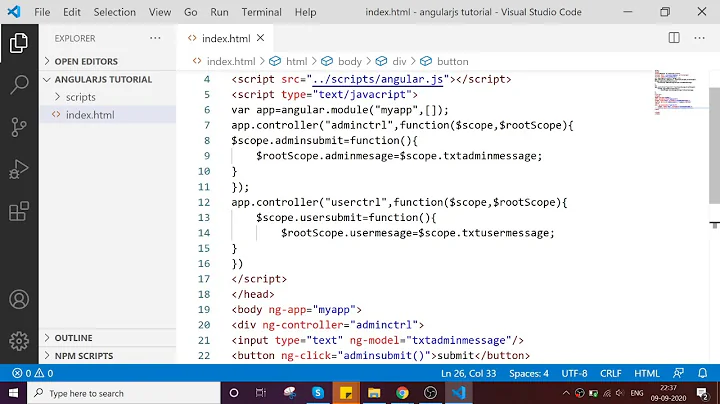AngularJS pass parameters in directive template to controller
Solution 1
You just need to change a very small piece of you code in order for your function call to receive the argument correctly
in your nodeList directive, call to your node like this:
<node ng-repeat="item in nodes" ng-model="item" delete-article="deleteArticle({node_item: node_item})" edit-article="editArticle({node_item: node_item})"></node>
and in your node directive, call to your nodeList like this:
<node-list ng-model="node.Options" delete-article="deleteArticle({node_item: node_item})" edit-article="editArticle({node_item: node_item})"></node-list>
So the reference "node_item" being passed correctly amongst children of children of children... to the top most parent (your controller:)
Have a look at this: Plunker
The reason:
Your <node-list> has its own scope, you need to pass "node_item" to the parent scope (your controller), simple! The tricky part is that the function is being called inside a grandchild scope (the <node>), so you then again need to pass "node_item" from the grandchild to the child.
You also don't need to create a new scope when calling compile. The $scope object you have there was also a new scope from the parent scope.
Solution 2
You can communicate between directives by using a controller and by making this dependency explicit. A simple example:
var myApp = angular.module('myApp', [])
.directive('foo', function () {
return {
restrict: 'E',
controller: function ($scope) {
this.property = 'something';
},
link: function (scope, element) {
}
};
})
.directive('bar', function() {
return {
require: '^foo',
link: function (scope, element, attrs, fooCtrl) {
console.log(fooCtrl.property);
scope.value = fooCtrl.property;
}
}
})
Here, directive bar declares a dependency to directive foo as an enclosing directive. Therefore, the directives can communicate as the link function is passed an additional argument. This HTML snipped will therefore display something:
<div ng-app="myApp">
<foo><bar>{{ value }}</bar></foo>
</div>
You can play with this example in this JSFiddle.
Related videos on Youtube
brabertaser19
Updated on June 04, 2022Comments
-
 brabertaser19 almost 2 years
brabertaser19 almost 2 yearsIn my app i have such directives:
.directive('nodeList', function($compile) { return { restrict: 'E', terminal: true, scope: { nodes: '=ngModel', deleteArticle: '&', editArticle: '&' }, link: function ($scope, $element, $attrs) { if (angular.isArray($scope.nodes)) { $element.append('<accordion close-others="true"><node ng-repeat="item in nodes" ng-model="item" delete-article="deleteArticle(node_item)" edit-article="editArticle(node_item)"></node></accordion>'); } $compile($element.contents())($scope.$new()); } }; }) .directive('node', function($compile) { return { restrict: 'E', terminal: true, scope: { node: '=ngModel', deleteArticle: '&', editArticle: '&' }, link: function ($scope, $element, $attrs) { if (angular.isArray($scope.node.Options) && $scope.node.Options.length > 0) { $element.append('<accordion-group><accordion-heading>{{node.Title}} <a href=\"javascript:void(0)\" ng-click=\"editArticle({node_item: node})\" data-toggle=\"modal\" data-target=\"#new-article\" class=\"action\"><i class=\"glyphicon glyphicon-edit\"></i></a></accordion-heading><node-list ng-model="node.Options"></node-list>{{node.Content}}</accordion-group>'); } else { $element.append('<accordion-group><accordion-heading>{{node.Title}} <a href=\"javascript:void(0)\" ng-click=\"editArticle({node_item: node})\" data-toggle=\"modal\" data-target=\"#new-article\" class=\"action\"><i class=\"glyphicon glyphicon-edit\"></i></a></accordion-heading>{{node.Content}}</accordion-group>'); } $compile($element.contents())($scope.$new()); } }; })and such html:
<node-list ng-model="articles" delete-article="deleteArticle(node_item)" edit-article="editArticle(node_item)"></node-list>and in controller:
$scope.editArticle = function(vArticle) {}when i have only one directive - all is clear, but how to pass parameters when my directive is calling another directive? is it real? and how?
-
 Ivan Chernykh over 9 yearsIt will be easier to help you (and to get the bounty) if you will create a jsfiddle or plnkr for us, please
Ivan Chernykh over 9 yearsIt will be easier to help you (and to get the bounty) if you will create a jsfiddle or plnkr for us, please -
 brabertaser19 over 9 years@Cherniv hm, i didn' know how to add ui bootstrap... embed.plnkr.co/LlzPgsWrwcYd59sa2wxd/preview
brabertaser19 over 9 years@Cherniv hm, i didn' know how to add ui bootstrap... embed.plnkr.co/LlzPgsWrwcYd59sa2wxd/preview -
 Pankaj Parkar over 9 yearswhile compiling DOM, why do you need $scope.$new() inside isolated scope?
Pankaj Parkar over 9 yearswhile compiling DOM, why do you need $scope.$new() inside isolated scope? -
 brabertaser19 over 9 years@pankajparkar to render childs of childs
brabertaser19 over 9 years@pankajparkar to render childs of childs
-
-
 brabertaser19 over 9 yearstake a look at my example, i didn't know how to implement it there
brabertaser19 over 9 yearstake a look at my example, i didn't know how to implement it there -
 brabertaser19 over 9 yearsi need to pass data from note which is currently clicked to controller wthis is not in directive
brabertaser19 over 9 yearsi need to pass data from note which is currently clicked to controller wthis is not in directive







